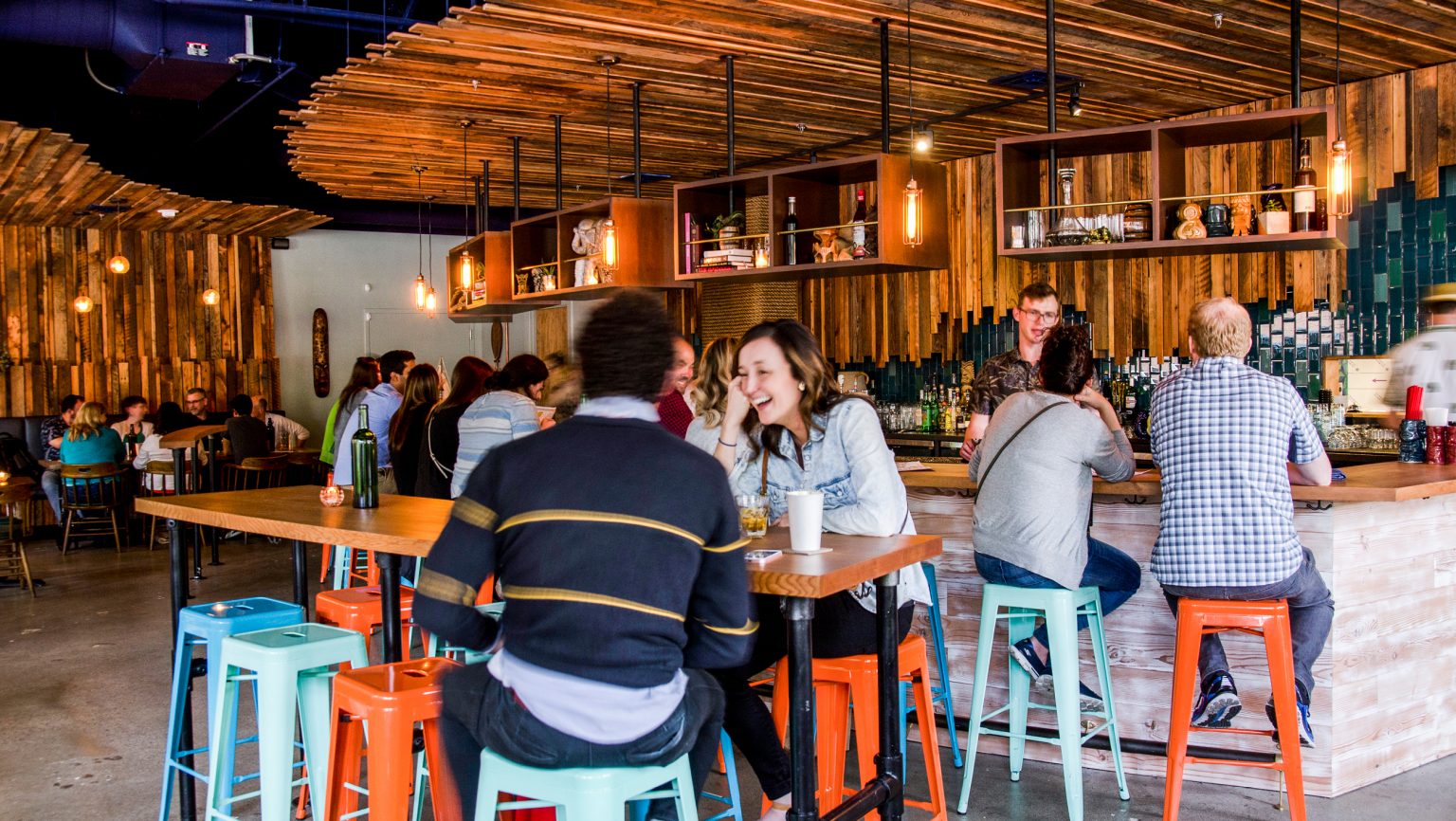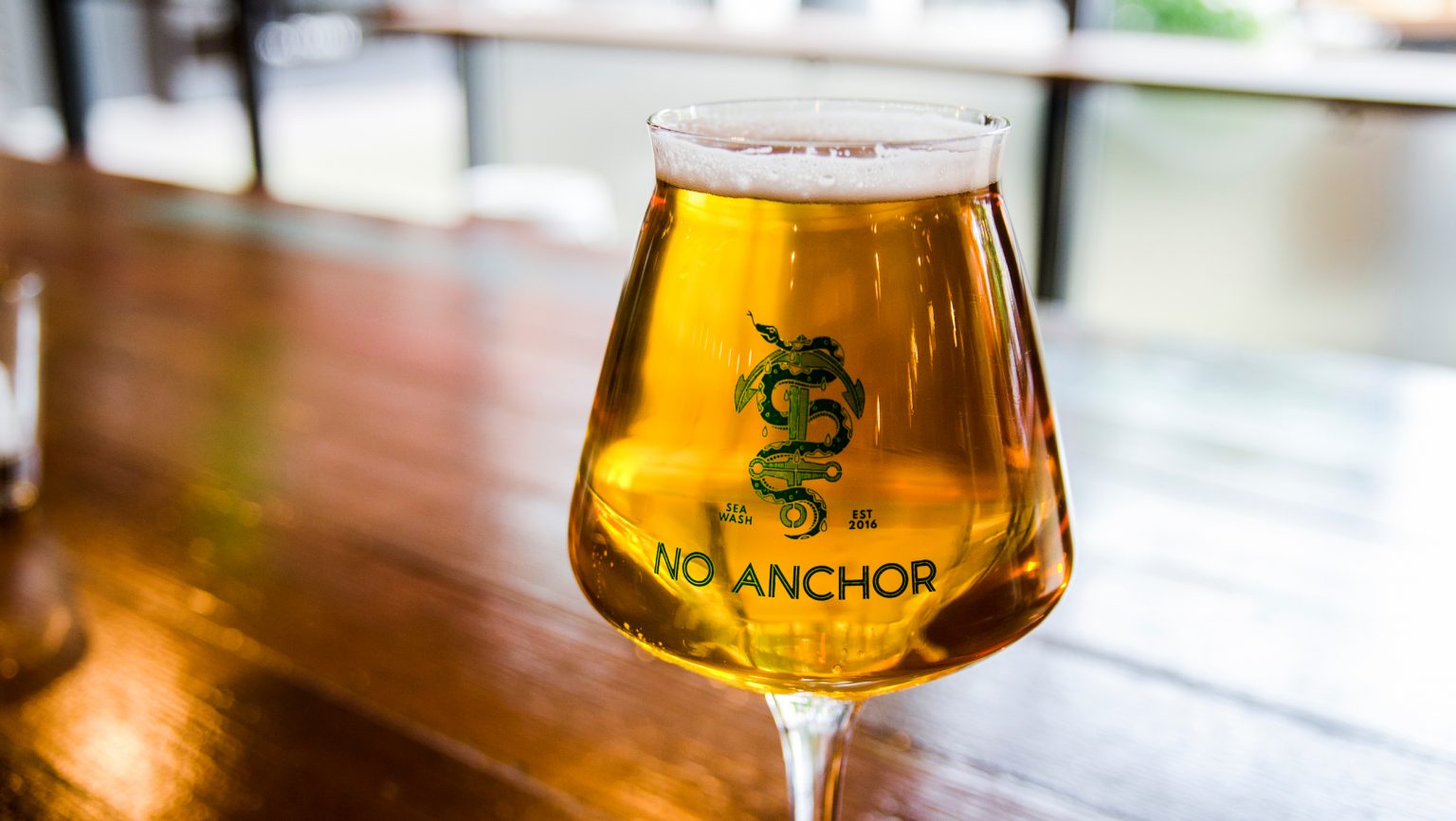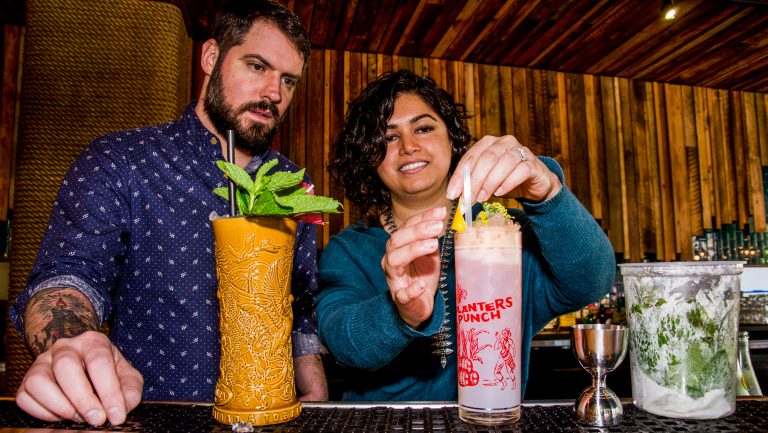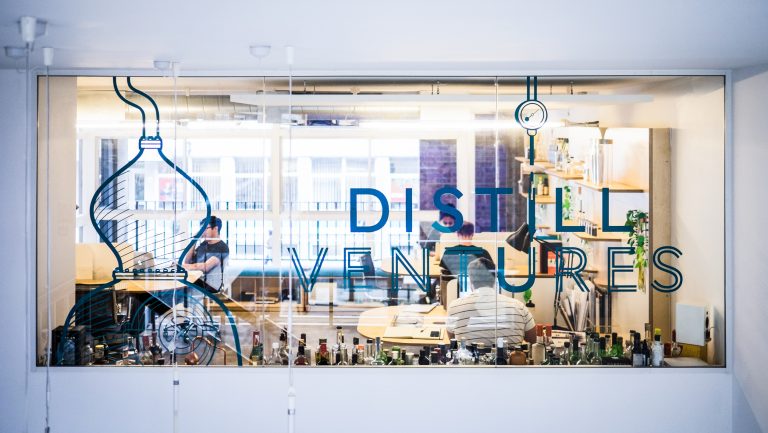In December 2015 beverage industry power couple Anu and Chris Elford, two of Seattle’s top bartenders, unveiled their plans to open an upscale beer bar, called No Anchor, and a tiki-inspired cocktail haven, Navy Strength, on one Belltown block. Ambitious, yes, but surely a snap for two proven operators with a clear vision and strong media buzz, right? It wasn’t so. The Elfords had to leap considerable hurdles to launch their concepts, with No Anchor finally opening its doors last fall, and Navy Strength not landing until the end of March.
Anu Elford, née Apte, has been one of the main drivers of Seattle’s cocktail renaissance since she took over the bar Rob Roy from its original owner in 2009. Her flair for the dramatic and her otherworldly skills when armed with a cocktail shaker—come for the punch with real gunpowder; stay for the flawless classics—put her and Rob Roy on the map, as well as countless national “best” lists.
At the same time, Chris was earning his stripes at New York City heavy hitters like Amor y Amargo and Gin Palace and then helping to open Proletariat, a beer geek’s dream in the East Village. He met Anu at a bourbon camp for bartenders in Kentucky and followed her to Seattle in 2013. In true celebrity fashion, the now-married partners even picked up a couple’s portmanteau: “Canoe,” which is the name of their restaurant group.

Don’t miss the latest drinks industry news and insights. Sign up for our award-winning newsletters and get insider intel, resources, and trends delivered to your inbox every week.

Navy Strength was designed to tap into what the Elfords saw as a nationwide trend: a return to fun drinks. Tiki, a category of cocktails that never took itself too seriously, was a perfect vehicle. The bar’s atmosphere is boisterous, and the decor favors subdued wood and enchanting jellyfish tanks over typical tiki thatch and kitsch. The drinks are fanciful, Instagrammable, and draw on global influences in a way that feels wholly unique. The menu shifts its focus to a new region of the world every six months.
Classics like daiquiris appear alongside originals like Masala Coffee Grog—a mash-up of India’s ubiquitous spiced street drinks and coffee grog, featuring anejo rum fat-washed with coffee-infused butter and blended with sweet vermouth and masala-spiced amaro, served on the rocks—and Amulet’s Glow, described cheekily on the menu as “a romp through the tropics on a sailboat with a basket of guavas, a bottle of pisco, and a jug of mezcal.” Everything from the juices to the allspice dram are made in house—a cost-cutting maneuver for owner-operators that has become an important selling point in top bars. The food follows suit; chef Jeffrey Vance filters Pacific Northwest seafood through the lens of a backyard barbecue, featuring snacks like smoked clam dip and raw albacore with cumin raita and pickled red onion. Soon Navy Strength will open an attached coffee and juice bar with the same upbeat vibe, sans alcohol, creating yet another revenue stream.
For a time, though, things looked pretty desperate; it seemed that none of this would come together. Shying away from traditional investors and lacking the means to finance the projects themselves, the Elfords were approved for a bank loan, only to have it rescinded shortly after they’d signed a lease and begun construction. The pair then canvassed family and friends and sought crowdfunding through EquityEats, trying frantically to save their dream. Says Chris, “A lot of people in our family stand to lose very significant pieces of their livelihood if these places aren’t successful.”
But mindful of that responsibility, he and Anu are more determined than ever to succeed. And as they reflect on the lessons they learned while opening their own bars, they hope that others who are inspired to do the same can avoid a few pitfalls along the way. Here’s what Anu and Chris shared from their difficult financing experience.

Don’t Sign a Lease Until Funding Is Approved
Like many small business owners, the Elfords didn’t have all the money they needed sitting in a bank account when they made plans to open their bars. What they did have was a proven track record as successful bartenders—a useful incentive for wooing investors. They were wary, however, of the strings attached to traditional investments. “We could have made it a lot easier on ourselves [had we been] willing to take on a big investor for a big chunk of equity,” Chris said, “but I’ve seen so many cases where that turns into negative interactions that can last years.”
This left a bank loan as the most attractive option for securing a lease. Chris describes the loan and lease as “this strange, cruel chicken-and-egg process of which line to sign first.” Ideally, both parts of the process would happen simultaneously, as each depends on the existence of the other. But in the real world, you have to decide which part to commit to first. Because the bank assured Anu and Chris that their loan would be no problem, the couple signed their lease to lock it down. When the bank pulled out at the last minute because the couple lacked collateral, the Elfords couldn’t afford their lease.
If given a do-over, the couple says they would probably hold out for the loan before signing for a space. But should another bar be in their future, Chris says he and Anu would prefer to fund it themselves, saving a nest egg first to achieve true independence.
Explore Crowdfunding
When the bank set them adrift, the Elfords turned to close contacts for financial support, rounding up the bulk of their shortfall. The two also crowdsourced through a platform called EquityEats, a company based in Washington, D.C., that had successfully assisted other industry veterans in opening new restaurants. Through EquityEats, early adopters could support the Elfords by purchasing gift cards at a discount, turning $500 into $750 credit to use at Rob Roy immediately, and at No Anchor and Navy Strength when they opened.
Though this method brought in less cash than expected, it generated plenty of goodwill. “Even though we got significantly less than [our contact at] EquityEats had initially hoped,” Chris says, “the cool thing about it is that it really helps you reach the community around you.” In the end, he’s not convinced that this was a bad way to go about raising money, noting that it’s possible for entrepreneurs with lower costs to raise their total funding this way.
Take Over an Existing Bar or Restaurant Space
Owners like the Elfords who put a premium on aesthetics are eager to instill their vision in all the designs and every component of their business. But the build-outs for Navy Strength and No Anchor, which replaced a convenience store and a long-empty space, were much more expensive than contractors initially estimated. This expense could have been mitigated by leasing real estate with basic restaurant infrastructure in place. In a booming city the size and density of Seattle, Chris says, “there are enough leases expiring, enough places going out of business—you just have to be really patient to find the right one.”
Sign a Long-term Lease
For his two bars, Chris refused to settle for anything less than a 10-year lease with two five-year options. “It’s the first five years that you’re generally paying things back, making little investments in infrastructure,” he says. “It’s in those second five years, and those hopefully second and third renegotiated leases, that you’re able to actually make some money and put some away.” Even if your plan is to turn your business for profit rather than put down deep roots in the community, the longer the lease, the better your odds of success.

Dispatch
Sign up for our award-winning newsletter
Don’t miss the latest drinks industry news and insights—delivered to your inbox every week.
Adam H. Callaghan is the editor of Eater Seattle and a freelance writer and editor specializing in food, fermentation, beverages, and travel. He hails from Maine and lives in Seattle with his partner, Stasia, and a variety of bubbling Ball jars.






